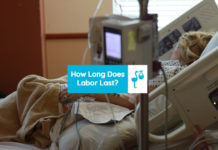Nobody wants to go under the knife especially in a labor room! Your concerns need to look beyond the fear of incision. There are many cesarean risks that make the pain of labor feel like a cakewalk.
A C-section is childbirth through an incision made in the abdomen and uterus. Sometimes when labor stalls or the fetus is under stress a C-section is necessary. In other cases, it is either willingly asked for or because of impatience.

Can you choose to have a C-section or natural birth?
Some recent studies reveal that most c-sections are done not out of compulsion. That is the opposite of what is ideal.
Advantages of normal delivery vs cesarean are endless. Unless you or your baby has some health issues a cesarean must be the last resort. And in that case, weighing the risk of c-section vs the emergency will make the prior negligible. When you are choosing whether to have c-section or natural delivery you consider the risks.
Even if you previously had a cesarean section it does not make you liable to have another. You can do a trial of labor after cesarean and have a VBAC.
What are the disadvantages of C-section?
A c-section carries risks for your current and future pregnancies. Whereas, vaginal birth is better with every regard. Recovery after vaginal delivery is faster and there is less chance of getting infections.
When the pregnancy is normal it is always advisable to have a natural delivery. This is because a C-section involves a surgical procedure. It takes weeks for the incision wound to heal. Sometimes the scar may remain there forever.
When your pregnancy has some complications then there is no way to avoid cesarean birth. So, until you can do try to have a vaginal birth.
Are cesarean sections safe?
When an experienced qualified doctor performs a cesarean then C-section is safe. The question is about the long term cesarean risks. It may affect your fertility and postpartum recovery from C-section. Taking care of the incision and stitches along with other precautions of cesarean aftercare is not easy. You can get infections and suffer from a lot of pain.
Is a C-section safer than a natural birth?
When you have some infections such as genital herpes then C-section is safer. Increasing age, dystocia, and other complications make C-section safer. Other than that natural delivery is always safer than C-section.
The planned cesarean is quite different than a normal delivery. You may not feel any pain and just go to the hospital on the date of operation. The doctors will administer epidural (anesthetics) and do the cesarean procedure.
When C-sections are emergency mitigation, the scenario is way different. In that situation, the risk of C-section is less than the risk of normal delivery. The risk of fetal death or rupture of tissues from labor is more than cesarean risks during dystocia. A hypotonic uterus dysfunction can also pose such a risk. It could be that the fetal heartbeat is dropping below the lower limit. Any hemorrhage during birth calls for C-section without considering its risks.
Which is worse C-section or natural birth?
The rise in the number of C-section from 5% to 20% in the US recently is attributed to advances in technology. Doctors are quicker in doing a C-section than before. Some women also opt for C-section because they don’t want to take the pangs of labor pain. But the decision makes the agony worse and suffering longer.
Difference between normal delivery and cesarean
During normal delivery, you undergo labor and have to push the baby through the birth canal. You might have to take epidural and let any surgical instrument touch you. In contrast, cesarean doesn’t involve you in birthing and you have to get an incision. There is no way that you go under the knife without anesthesia.
Your baby also benefits from the labor, lungs open up while passing through the birth canal. In cesarean, the fetus has the risk of respiratory problems.
Vaginal birth
A vaginal birth doesn’t involve any scars or incisions. The mortality rate of mothers having a normal delivery is lesser than those who plan C-section.
Benefits of Vaginal birth
- A surge of hormones ripens the cervix and helps during the lactation phase
- Your body bathes in a pool of oxytocin which is the comforting love hormone, helps baby bond with you
- Amniotic fluid moves out of the baby’s lungs
- No scarring or episiotomy if your muscles are strong
- Baby gradually comes out and gets some bacteria from your body. Vitamin K is essential for preventing bleeding and intestinal bacteria synthesize it.
- Better for having multiple pregnancies as fertility does not suffer
- Less risk of hysterectomy, blood loss, blood clots
- Mother mortality and fetal mortality is lower
Vaginal birth Cons
- Vagina has to tear a bit and can affect sexual intercourse
- Your baby might not be able to withstand stress, but you do get a fetal nonstress test to assess that at 28 weeks
- Cannot schedule birth
Cesarean birth
There are benefits of cesarean that enable women who have complications to become mothers. Probably you heard that C-sections enable mermaids to give birth. But when there is no such need for cesarean the benefits of C-section are nullified.
What are the chances of dying during a C-section? The fetal mortality rate during C-section is twice that of natural birth. Mother morbidity is also higher during a cesarean.
A planned cesarean might save you from labor pain but it can also lead to a premature baby. Miscalculation of the due date might bring your baby out before the right time.
What will I feel during a cesarean section?
You will not feel anything during a planned cesarean. A high dose of epidurals and anesthetics will make the area below waist numb. Your doctor will make an incision and take your baby out. Then he will fix the incision with glue, staples or stitches.
You will have to stay in the hospital until the dressing changes last time. The healing process is longer and continues for weeks.
In case of an unplanned cesarean, things will be different. You will first wreath in pain during labor and then whatever be the case it will halt. Not the pain, but the contractions. So your doctor will give you epidural and you’ll be immobile. Then anesthesia will induce deep sleep and the same cesarean procedure performed.
What is more painful C-section or natural birth?
Post-cesarean complications make it painful during the long run. When you have a planned cesarean then a normal delivery will be more painful. Any injury to surrounding organs can lead to more pain after cesarean. As the anesthesia will lose its effect you’ll start feeling the pain from C-section.
Is C-section dangerous?
No, it is not dangerous, it is a medical provision for its benefits. But the post-cesarean complications may occur.
What are the Cesarean Risks?
Side effects after cesarean delivery affect your fertility, baby’s health, and emotional well being. After cesarean, you are at higher risk or suffering from postpartum depression. Multiple C-section complications are so severe that you may undergo removal of complete organs.
What are the long term effects of a C-section?
Long term effects of C-section mainly affect the uterus and in turn your fertility. If you get a scar or cesarean fibroid then you may become infertile. Your uterus can lose its ability to sustain a pregnancy.
What are the second Cesarean Risks?
After a second c section if it leads to a high incision you lose your ability to deliver normally.
Major 15 cesarean risks for mother
1) Painful post cesarean phase
The pain during labor may be the reason you are an option a cesarean. But the post-delivery period after a C-section is more painful. You will have difficulty walking and urinating. Infections can make things even worse. As the numbness will go from your body acute pain will start. This will prevent you from taking care of your baby.
2) Injury to the bladder and adjacent organs
The surrounding organs can damage due to surgery. A bladder injury is most common after a cesarean. It will lead to urinary incontinence. But doctors can correct the problem while the cesarean takes place. With subsequent surgeries, organ adhesions will make it more common to damage them. This will make the cesarean duration longer.
3) Long recovery and additional care
Cesarean aftercare has many precautions to follow. The stitches can have inflammation and will need treatment. Cesarean recovery period makes a longer hospital stay compulsory.
4) Infections
You can get different types of infections after C-section. The incision can get an infection and spread to other regions. If the uterine wall gets infected then it can spread to the urinary tract.
5) Endometriosis from C-section
After surgery, the adhesions and scars can cause the growth of tissue into other organs. Endometriosis affects fertility extensively and can even lead to amenorrhea. As the tissue moves into other organs it hampers their functioning too.
6) Blood loss
The bleeding during C-section can give rise to the need for blood transfusion. A study showed loss of blood greater than 1 L in about 9.2% cesarean. Out of every 6 cesarean cases, 1 needs a blood transfusion. Whether the C-section is elective or emergency the blood loss remains high.
7) Placenta Previa and Placenta accreta
The condition Placenta Previa refers to extremely low lying placenta that can cover the cervix. It can be marginal, partial or complete covering of the cervix. The risk of Placenta Previa rises to 2 or 3 out of every 100 women who have their 4th, 5th or 6th C-section.
When a woman has Placenta Previa she has a high risk of developing Placenta accreta. Placenta accreta is the condition when the placental tissues attach to the wall deeply. The occurrence of adhesion from previous C-section also increases the chance of having placenta accreta.
8) Hysterectomy & additional operations
During certain complications, the entire uterus will be removed. Many women need additional surgeries for skin lesions or removal of tissue masses. This can happen weeks after C-section. Long term cesarean risks include such additional surgeries.
9) Adhesions
If a woman has undergone cesarean multiple times then the scar tissues can attach nearby organs. This leads to blockage and painful symptoms. Placenta accreta is also due to adhesion near the previous C-section scar. The adhesions can be in the pelvic region that later increase risk of bladder injury during repeat cesarean.
10) Impact on fertility
With subsequent C-section, the risks increase. The uterus can get fibroid tissue and normal delivery becomes more difficult. Scars and adhesions from the previous cesarean make it difficult to cut through. The time taken during cesarean increases with the number of times you get it.
11) Maternal morbidity and mortality
Maternal death during a cesarean is more likely. Morbidity due to C-section is so severe that mothers die a few days after it. Proper care and support is a must. Nutritional demand for supplements also increases after a complicated cesarean.
12) Thromboembolism
It is common to have blood clots post-C-section. They can move around through the bloodstream and reach legs and back. The pain due to thromboembolism is severe and they can be fatal. When these clots move to the pulmonary region they lead to pulmonary embolism. It is one of the most common causes of death after c section.
13) Anesthesia after effects
Side effects of a high dose of anesthetics give headaches. After it leaves your body you can have severe headaches and nausea. The sudden feeling of pain after the withdrawal of epidural effects is tormenting.
14) Postpartum depression
One of the risk factors of postpartum depression is undergoing trauma during delivery. If you have an emergency cesarean the risk of postpartum depression is higher.
15) Breastfeeding troubles and missing bonding
Cesarean delivery does not allow enough secretion of oxytocin. The hormone is essential for milk ejection reflex. It is also responsible for developing the bond between you and your baby.
Cesarean section risks to the baby
Cesarean baby vs normal baby is at certain risks. The newborn needs to stay in NICU for longer than a normal delivery baby. They may need extra care and assisted breathing support.
1) Respiratory problems
When the baby passes through the birth canal the amniotic fluid comes out of the lungs. During a cesarean, the baby does not pass through the birth canal. Later in life, cesarean babies may have asthma and other respiratory problems.
2) Premature birth
Miscalculation of the due date may lead to premature birth. Survival rates of premature babies are lower. This poses a risk to the life of the newborn.
3) Can get a small accidental cut by the doctor
Very rarely the baby may be nicked during the surgery. However, the healing of such cuts is very quick.
4) Risk of obesity
Long term effects of C-section on baby state show a higher risk of being obese.
5) Poor nutrition due to low milk supply
Breastfeeding problems can lead to malnutrition. The baby does not get the good bacteria from the birth canal. This leads to a compromised immune system.
Even if your birth plan has a normal delivery, you can have an emergency situation. Always remember that C-section pros and cons don’t count when it is an emergency.





![Why Do You Fast Before Cesarean? [Fasting Before C-Section Facts] Why do you fast before Caesarean?](https://www.pregnanteve.com/wp-content/uploads/2019/03/fast_before_cesarean-218x150.jpg)



